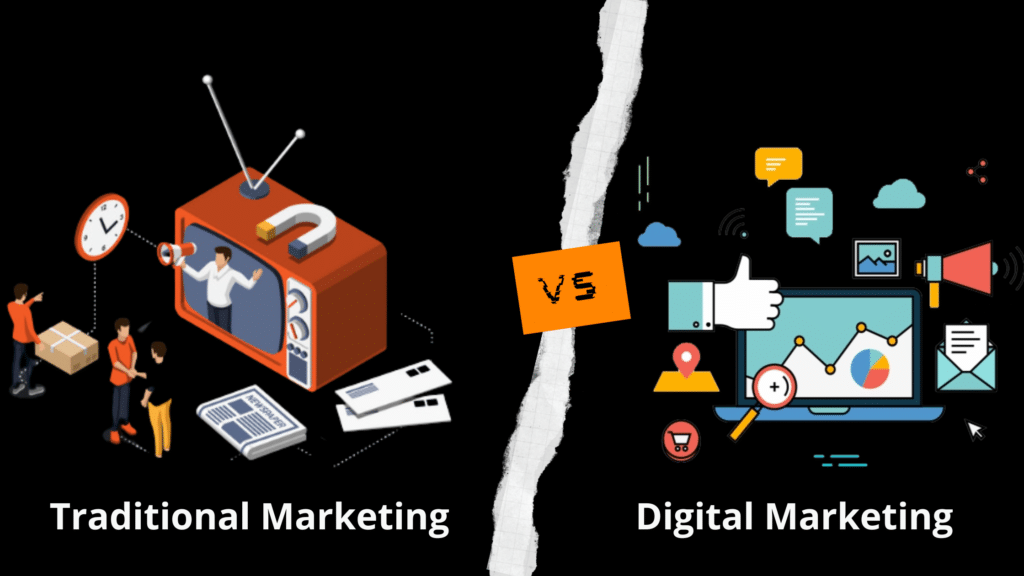Traditional advertising and digital advertising differ in terms of the channels, methods, and characteristics involved. Here are some key distinctions between the two:
- Channels and Mediums: Analog advertising primarily utilizes traditional offline channels, such as print media (newspapers, magazines), broadcast media (television, radio), billboards, direct mail, and physical signage. Digital advertising, on the other hand, leverages online channels and platforms, including websites, search engines, social media, mobile applications, email, video streaming platforms, and more.
- Reach and Targeting: Analog advertising often has a broader reach, targeting a mass audience without the ability to personalize or target specific demographics or interests. Digital advertising enables precise targeting, leveraging data and user insights to deliver personalized messages to specific audiences or segments. It allows advertisers to reach individuals who are more likely to be interested in their products or services.
- Interactivity and Engagement: Analog advertising typically provides limited interactivity and engagement opportunities. For example, a print ad in a magazine is static and does not allow immediate user interaction. Digital advertising offers interactive elements such as clickable links, videos, quizzes, polls, and forms, which can engage users, encourage participation, and drive immediate actions.
- Measurement and Analytics: Analog advertising often lacks detailed measurement and analytics capabilities. It can be challenging to track the impact and effectiveness of analog campaigns accurately. In contrast, digital advertising provides extensive measurement and analytics tools, allowing advertisers to track metrics like impressions, clicks, conversions, engagement rates, and ROI. This data helps assess campaign performance, optimize strategies, and make data-driven decisions.
- Cost and Flexibility: Analog advertising, such as TV commercials or print ads, can be costly due to production and placement expenses. Digital advertising offers more flexibility, allowing advertisers to set budget limits, adjust campaigns in real-time, and optimize spending based on performance. Digital ads also have the potential for broader reach at a lower cost compared to some traditional analog methods.
- Real-Time and Dynamic Optimization: Digital advertising allows real-time campaign monitoring and optimization. Advertisers can make adjustments to targeting, creative elements, and messaging on the fly to optimize performance. Analog advertising does not offer the same level of agility and real-time optimization.
Traditional marketing encompasses the marketing methods that can be used without the internet. These are the methods that have been around for decades and are typically used less often now. However, they’re not without their strengths.
Some of the conventional methods used in the market are:
- Directly mailed postcards, coupons, and informational packets
- Television or radio commercials
- Newspaper or magazine ads
- Billboards and fliers
- Telephone calls and text notifications
Digital marketing strategies evolve quickly because of trends and new technology. These strategies include those that require the use of the internet or smartphones. They haven’t been around as long as traditional methods, but they certainly pack a punch.
Some of the most commonly used digital marketing methods are:
- Website content
- Email campaigns
- Content marketing
- Social media posts
- Clickable ads
- Affiliate marketing
- Search engine optimization (SEO)
It’s worth noting that while digital advertising has gained significant prominence in recent years, analog advertising still holds value in certain contexts. Many advertising strategies combine both analog and digital approaches to reach a broader audience and achieve marketing objectives effectively. The choice between analog and digital advertising depends on factors such as target audience, budget, campaign goals, and the nature of the products or services being promoted.

Fantastic website. A lot of helpful information here. I¦m sending it to a few buddies ans additionally sharing in delicious. And obviously, thanks for your sweat!
F*ckin’ remarkable things here. I am very glad to see your article. Thanks a lot and i’m looking forward to contact you. Will you kindly drop me a e-mail?
Oh my goodness! a tremendous article dude. Thanks Nevertheless I am experiencing problem with ur rss . Don’t know why Unable to subscribe to it. Is there anybody getting an identical rss problem? Anybody who is aware of kindly respond. Thnkx
I love forgathering useful information , this post has got me even more info! .
acheter medicamentos en Argentina Nihon Oaxaca farmaci da acquistare in farmacia
Fantastic website. Lots of useful info here. I’m sending it to some pals ans additionally sharing in delicious. And certainly, thank you to your sweat!
I think this site contains some really fantastic information for everyone :D. “Calamity is the test of integrity.” by Samuel Richardson.
I am glad to be one of many visitants on this outstanding website (:, regards for posting.
I am now not sure where you are getting your information, however great topic. I needs to spend a while studying much more or figuring out more. Thanks for great info I was in search of this information for my mission.
An fascinating discussion is worth comment. I think that you need to write extra on this topic, it may not be a taboo subject but generally individuals are not enough to talk on such topics. To the next. Cheers
Thanks for finally writing about > Difference between traditional
and digital advertising – AdOps Trends < Liked it!
Thanks for your whole hard work on this site. My mother takes pleasure in managing investigations and it’s really simple to grasp why. All of us hear all of the dynamic medium you provide worthwhile tips and hints on the web blog and as well as attract response from the others on the area of interest while our girl is becoming educated a great deal. Enjoy the remaining portion of the year. You’re the one carrying out a terrific job.